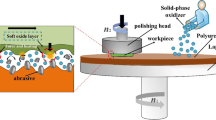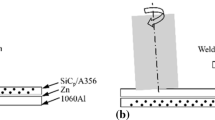Abstract
To improve the efficiency and surface quality in tribochemical mechanical lapping of 6H–SiC single-crystal substrate, the effects of oxidant type, content and abrasive size on the material removal rate (MRR) and surface roughness were studied in this paper. The results show that different oxidants have their maximum of material removal rate at their respective optimum content, namely 1768 nm/min for 10% wt sodium hydroxide, 1382 nm/min for 5% wt potassium permanganate and 1271 nm/min for 5% wt dichromium trioxide, respectively. However, the types and contents of oxidants have little effect on the surface roughness of SiC after lapping. Therefore, 10% wt NaOH was chosen as the oxidant of tribochemical mechanical lapping paste for lapping 6H–SiC single-crystal substrate. The abrasive size had a great influence on the material removal rate in lapping 6H–SiC single-crystal substrate. When the abrasive size is 28 µm in diameter, the material removal rate reaches the maximum value, but the surface roughness also is the maximum value after lapping. Then, the composition of optimized lapping paste was obtained. Research results show that the larger the abrasive using in lapping paste is, the larger the MRR and surface roughness are in certain range. The tribochemical reactions on the surface of SiC will occur and oxides of SiO2 or Si(OH)4 or Na2SiO3 or the compound of SiO2, Na2SiO3 and Si(OH)4 produced on the surface of SiC will be removed by the abrasives.




Similar content being viewed by others
References
S.P. Xu, J.B. Lu, Q.S. Yan, Solid catalysts based on fenton reaction for SiC wafer in chemical mechanical polishing. J. Mech. Eng. 53(21), 167–173 (2017)
P. Zhang, Research on the key technologies of ultra precision polishing of silicon carbide single crystal substrate. Shandong University, (2017).
H. Wang, Epitaxial process of graphene on SiC substrate and raman characterization. Xi'an University of Electronic Science and technology, (2012).
J.J. Liu, Y.K. Liu, Y.L. Tang et al., Research status and new progress of sic power electronic devices. Semicond. Technol. 42(10), 744–753 (2017)
X.F. Chen, J. Li, D.Y. Ma et al., Fine machining of large- diameter 6H-SiC wafers. J. Mater. Sci. Technol. 22(5), 681–684 (2006)
S.J. Li, H.M. Hu, Y. Li et al., Mechanism and experiment on lapping SiC single crystal wafer. J. Synth. Cryst. 42(10), 2065–2070 (2013)
Q. Xiao, X.L. He, Recent progress in machining process of SiC single crystal. Mater. Rev. 28(1), 6–10 (2014)
Y. Hu, D. Shi, Y. Hu et al., Investigation on the material removal and surface generation of a single crystal SiC wafer by ultrasonic chemical mechanical polishing combined with ultrasonic lapping. Materials 2022(11), 1–13 (2018)
H.M. Hu, S.J. Li, X.C. Gao et al., Simulation and experiment of MRR in lapping process of SiC monocrystal wafers. Acta Armamentarii 34(9), 1125–1131 (2013)
H. Zhou, X.M. Xu, X. Gao et al., Research on the distribution of subsurface damage layer on SiC substrate after double-side lapping. J. Adv. Manuf. Syst. 14(1), 1–10 (2015)
J.S. Pang, Q.S. Yan, W. Li, Analysis on surface performance of 6H-SiC monocrystalline wafer with single-sided lapping method. Diam. Abras. Eng. 34(6), 1–6 (2014)
J.S. Pan, Research on ultra precision abrasive machining mechanism of monocrystalline SiC substrates. Guangdong University of Technology, (2015).
K. Yamaguchi, M. Touge, A. Kubota et al., Study on high efficiency mirror finished technique of single-crystal SiC substrate-the penalization process by constant-pressure grinding and an ultraviolet irradiation assisted polishing. J. Jpn. Soc. Precis. Eng. 77(1), 116–202 (2011)
T. Kido, M. Nagaya, K. Kawata et al., A novel grinding technique for 4H-SiC single-crystal wafers using tribo-catalytic abrasives. Mater. Sci. Forum 778–780(2), 754–758 (2014)
J.X. Su, J.X. Du, H.N. Liu et al., Research on material removal rate of CMP 6H-SiC crystal substrate (0001) Si surface based on abrasive alumina (Al2O3). Proc. Eng. 24, 441–446 (2011)
J.X. Su, J.X. Du, L.J. Ma et al., Material removal rate of 6H-SiC crystal substrate CMP using an alumina (Al2O3) abrasive. J. Semicond. 33(10), 106003 (2012)
J.X. Su, X.M. Zhang, X.Y. Wan et al., Study on fixed abrasive lapping SiC single crystal substrate (0001) C surface. Nanotechnol. Precis. Eng. 12(6), 417–423 (2014)
J.X. Su, J.J. Li, Z.K. Wang et al., Mechanism and process parameters of lapping 6H-SiC crystal substrate based on diamond particle. Acta Tech. 62(4B), 1–12 (2017)
Y. Chen, Research on chemical mechanical polishing of single-crystal SiC based on fenton reaction. Guangdong University of Technology, (2017).
T. Song, The nano-mechanical property research for single crystal sillicon carbide corrosion film based on fenton reaction. Guangdong University of Technology, (2016).
L. Wang, Research for chemical mechanical polishing solution based on fenton reaction for single crystal SiC. Guangdong University of Technology (2015).
V.A. Muratov, T.E. Fischer, Tribochemical Polishing. Annu. Rev. Mater. Sci. 30, 27–51 (2000)
X.L. Liu, Study on SiC crystal substrate grinding with consolidation abrasive. He’nan University of Technology, (2013).
L. Jordi, C. Iliev, T. Fischer, Lubrication of silicon nitride and silicon carbide by water: running in, wear and operation of sliding bearings. Tribol. Lett. 17(3), 367–376 (2004)
M. Matsuda, K. Kato, A. Hashimoto, Friction and wear properties of silicon carbide in water from different sources. Tribol. Lett. 43(1), 33–41 (2011)
V. Presser, Oxidation and wet wear of silicon carbide. Universität Tübingen, (2009).
D. Kuhlmann-Wilsdorf, Flash temperatures due to friction and Joule heat at asperity contacts. Wear 105(3), 187–198 (1985)
T.F.J. Quinn, Computational methods applied to oxidational wear. Wear 199(2), 169–180 (1996)
R. Gates, S. Hsu, Tribochemistry between water and Si3N4 and SiC: induction time analysis. Tribol. Lett. 17(3), 399–407 (2004)
R.Q. Wang, Five misunderstandings in the experiment of sodium hydroxide properties. Chem. Teach. 7, 62–64 (2016)
M. Jiang, R. Komanduri, On the finishing of Si3N4 balls for bearing applications. Wear 215(1–2), 267–278 (1998)
Y.C. Lin, C.H. Kao, A study on surface polishing of SiC with a tribochemical reaction mechanism. Int. J. Adv. Manuf. Technol. 25(1), 33–40 (2005)
S. Kitaoka, T. Tsuji, Y. Yamaguchi et al., Tribochemical wear theory of non-oxide ceramics in high temperature and high-pressure water. Wear 205(1–2), 40–46 (1997)
P.F. Fan, W.J. Zhai, X.X. Zhang, Effects of electric potentials on tribological properties of SiC/HT200 pairs in NaOH solutions. J. Harbin Inst. Technol. 23(3), 75–60 (2016)
J.F. Li, J.Q. Huang, S.H. Tan et al., Tribological properties of toughened SiC ceramics under water-lubricated sliding. J. Chin. Ceram. Soc. 26(3), 305–312 (1998)
L.J. Hao, Study on electrical friction characteristics of silicon carbide ceramics during polishing. Harbin Institute of Technology, (2008).
J. Le, S. Herbert, A. Georg, Experimental study on the tribo-chemical smoothening process between self-mated silicon carbide in a water-lubricated surface contact reciprocating test. Friction 7(2), 181–191 (2019)
J.F. Luo, A.D. David, Material removal mechanism in chemical mechanical polishing: theory and modeling. IEEE Trans. Semicond. Manuf. 14(2), 112–133 (2001)
Y. Wang, Y.S. Zuo, Z.J. Jin, Analysis of material removal rate in lapping of the hard alloy rings. Mech. Eng. Technol. 4, 127–134 (2015)
Q.L. Yuan, H. Fu, S.J. Li, Study on material removal rate in lapping of SiC single crystal wafer. Mech. Sci. Technol. Aerosp. Eng. 37(12), 1769–1775 (2018)
Z.C. Ding, S.J. Li, Z. Li, Research on transition characters of plastic and brittle for scribing SiC single crystal. J. Synth. Cryst. 45(11), 2614–2625 (2016)
Acknowledgements
The authors acknowledge the financial support of the National Natural Science Foundation of China (No. U1804142), Science and Technology Research Project of Henan Province (No. 192102210058).
Author information
Authors and Affiliations
Corresponding author
Additional information
Publisher's Note
Springer Nature remains neutral with regard to jurisdictional claims in published maps and institutional affiliations.
Rights and permissions
About this article
Cite this article
Jianxiu, S., Rui, X., Yipu, W. et al. Study on Lapping Paste of 6H–SiC Single-Crystal Substrate in Tribochemical Mechanical Lapping. J. Inst. Eng. India Ser. E 101, 141–148 (2020). https://doi.org/10.1007/s40034-020-00167-0
Received:
Accepted:
Published:
Issue Date:
DOI: https://doi.org/10.1007/s40034-020-00167-0




